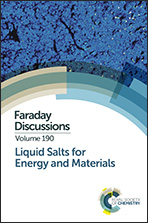Development of a niobium-doped titania inert anode for titanium electrowinning in molten chloride salts†
Abstract
The direct electrochemical reduction of solid titanium dioxide in a chloride melt is an attractive method for the production of titanium metal. It has been estimated that this type of electrolytic approach may reduce the costs of producing titanium sponge by more than half, with the additional benefit of a smaller environmental footprint. The process utilises a consumable carbon anode which releases a mixture of CO2 and CO gas during electrolysis, but suffers from low current efficiency due to the occurrence of parasitic side reactions involving carbon. The replacement of the carbon anode with a cheap, robust inert anode offers numerous benefits that include: elimination of carbon dioxide emissions, more efficient cell operation, opportunity for three-dimensional electrode configurations and reduced electrode costs. This paper reports a study of Nb-doped titania anode materials for inert anodes in a titanium electrolytic reduction cell. The study examines the effect of niobium content and sintering conditions on the performance of Nb-doped TiO2 anodes in laboratory-scale electrolysis tests. Experimental findings, including performance in a 100 h laboratory electrolysis test, are described.
- This article is part of the themed collection: Liquid Salts for Energy and Materials

 Please wait while we load your content...
Please wait while we load your content...